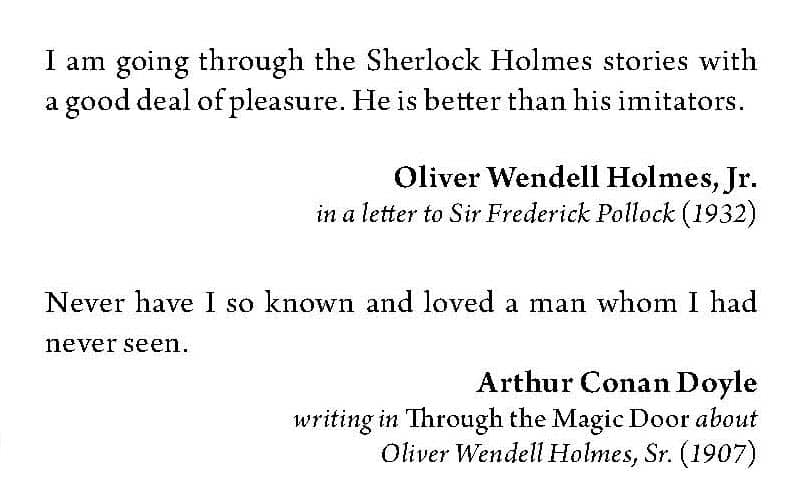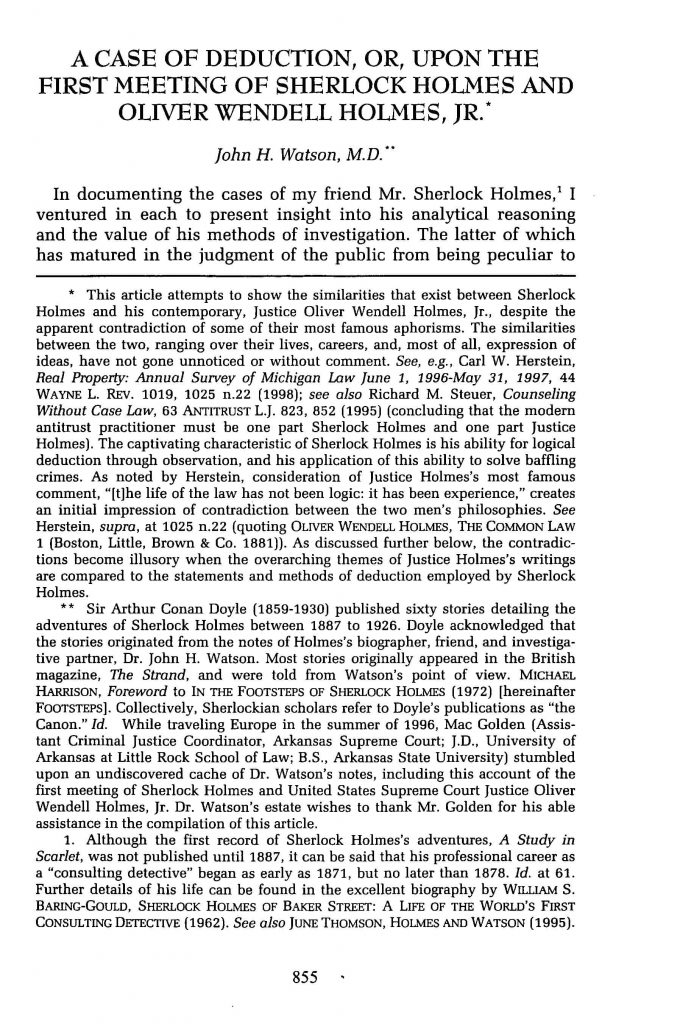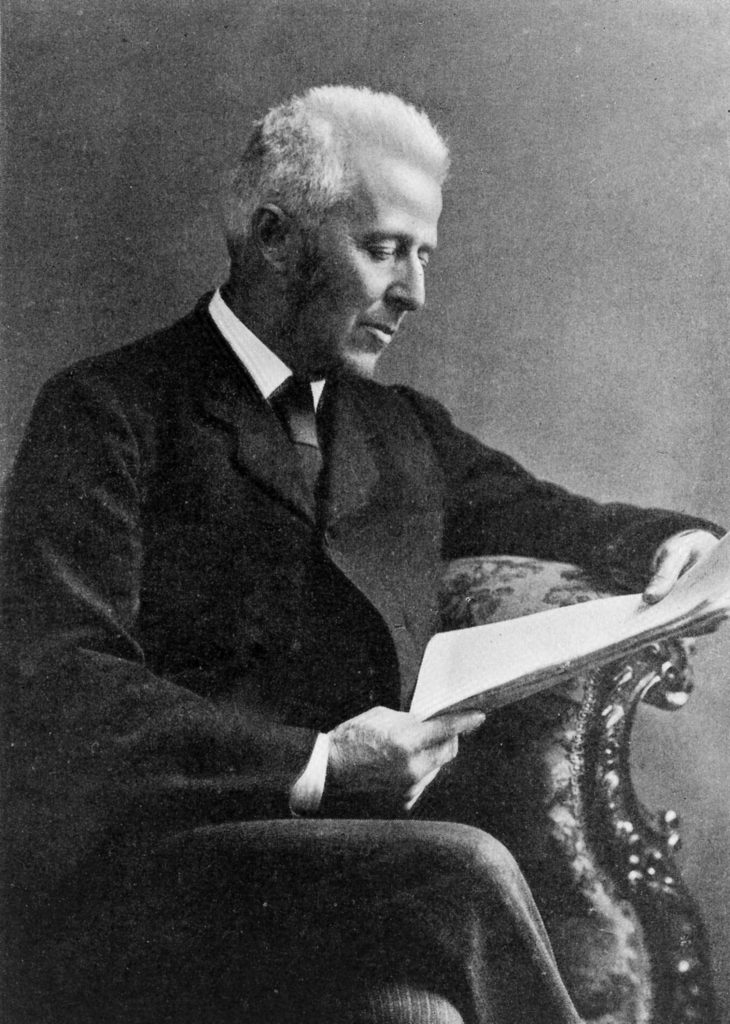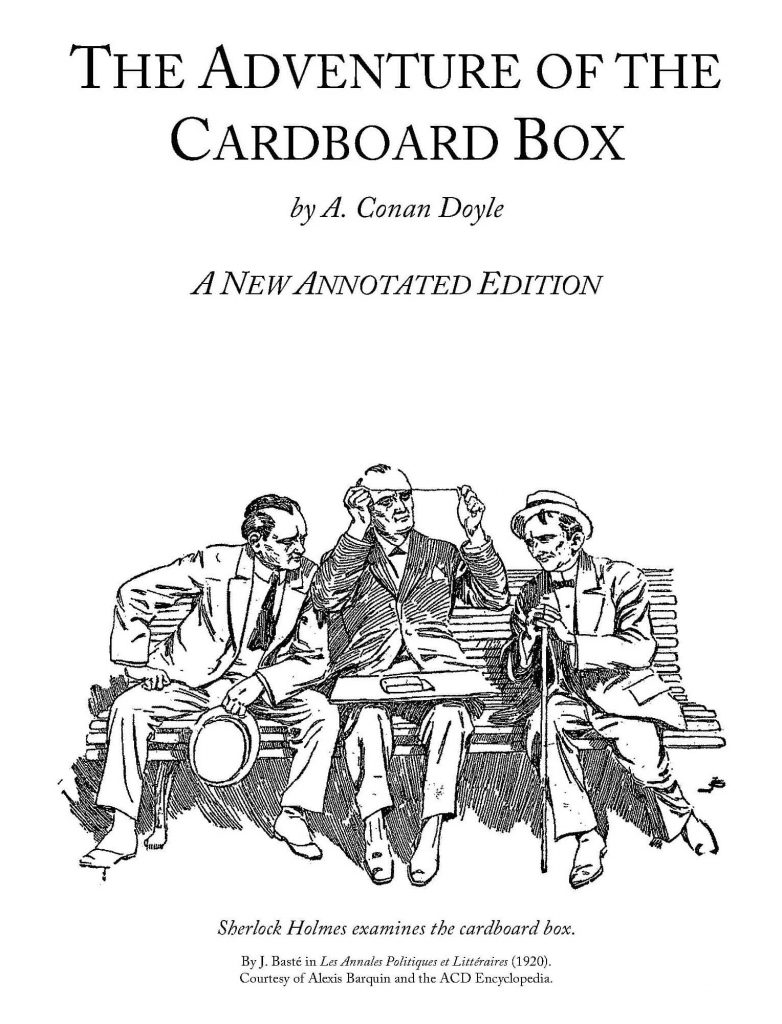This was a lofty chamber, lined and littered with countless bottles. Broad, low tables were scattered about, which bristled with retorts, test-tubes, and little Bunsen lamps, with their blue flickering flames. There was only one student in the room, who was bending over a distant table absorbed in his work. At the sound of our steps he glanced round and sprang to his feet with a cry of pleasure. “I’ve found it! I’ve found it,” he shouted to my companion, running towards us with a test-tube in his hand. “I have found a re-agent which is precipitated by haemoglobin, and by nothing else.” Had he discovered a gold mine, greater delight could not have shone upon his features.
“Dr. Watson, Mr. Sherlock Holmes,” said Stamford, introducing us.
“How are you?” he said cordially, gripping my hand with a strength for which I should hardly have given him credit. “You have been in Afghanistan, I perceive.”
“How on earth did you know that?” I asked in astonishment.
“Never mind,” said he, chuckling to himself.
And so two of literature’s most famous characters, Dr. John Watson and Sherlock Holmes, met for the first time. Sherlock Holmes is arguably one of the most famous detectives, fictional or real, in the world. His adventures have delighted readers ever since the first Sherlock Holmes story, A Study in Scarlet, was published in 1887. Arthur Conan Doyle wrote fifty-six short stories and four novels featuring Holmes and Watson, and they have never gone out of print.
Sherlock scholars, known as Sherlockians, have traditionally celebrated January 1, 1881, as the day Holmes and Watson met. So in honor of another new year, this January on the HeinOnline Blog we are indulging our literary side, proving that HeinOnline truly is a multidisciplinary platform by using it to explore some interesting facts about Sherlock Holmes.
1. A Holmes by Any Other Name
Today, the name Sherlock Holmes is famous worldwide. Whether you have read one of the original stories or not, the name Sherlock Holmes immediately conjures an image of a man with a pipe in a deerstalker hat, magnifying glass in hand. Call someone a Sherlock, sincerely or sarcastically, and it is immediately understood to be a comment on their intelligence.
But Arthur Conan Doyle wasn’t always sold on the name. In his first draft of A Study and Scarlet, Conan Doyle’s detective was Sherrington Hope. His hero’s name quickly changed to Sherrington Holmes and then Sherrinford Holmes before becoming Sherlock Holmes.
Scholars have debated Doyle’s inspirations for his detective’s rather unusual first name, but the inspiration for his surname is well-documented. Doyle greatly admired the works of writer and fellow physician Oliver Wendell Holmes. Holmes was an incredibly popular and prolific poet as well as a pioneering physician. He controversially theorized in 1850 that puerperal fever could be prevented if physicians sterilized their instruments and washed their hands.
Holmes is also known for being the father of Oliver Wendell Holmes, Jr., who was an associate justice of the U.S. Supreme Court from 1902–1932. In his thirty years on the nation’s highest court, Justice Holmes was one of the most influential justices and legal scholars[1]Harry C. Shriver, Oliver Wendell Holmes: Lawyer, 24 A.B.A. J. 157 (1938). This article is found in HeinOnline’s Law Journal Library. of his time, famous for his witty and numerous dissents.[2]Tom W. Campbell. Four Score Forgotten Men: Sketches of the Justices of the U.S. Supreme Court (1950). This book is found in HeinOnline’s History of Supreme Court Nominations. Justice Holmes’ illustrious career can be fully explored in numerous books and articles within HeinOnline, but particularly within the History of Supreme Court Nominations database, where users will find Holmes’ own works and a study of Holmes’ time on the Court written by another of the Court’s most famous members, Felix Frankfurter.[3]Felix Frankfurter. Mr. Justice Holmes and the Supreme Court (1961). This book is found in HeinOnline’s History of Supreme Court Nominations.

One of the more whimsical items in HeinOnline is an article[4]John H. Watson, A Case of Deduction, or, upon the First Meeting of Sherlock Holmes and Oliver Wendell Holmes, Jr., 24 UALR L. REV. 855 (2002). This article is found in HeinOnline’s Law Journal Library. directly connecting the jurist and the detective. It imagines a “real” meeting between Sherlock Holmes and Mr. Justice Holmes and is ostensibly written, like the original Holmes stories, from the point of view of Dr. John Watson.

2. The “Real” Sherlock Holmes
Arthur Conan Doyle famously drew inspiration for Sherlock Holmes from Dr. Joseph Bell,[5]Perspectives on Arthur Conan Doyle and Evidence, 4 INT’l COMMENT. on EVIDENCE [i] (2006). This article is found in HeinOnline’s Law Journal Library. one of his medical school teachers. Bell astounded aspiring doctors and patients with his ability to “diagnose the people as they came in, before they even opened their mouths. He would tell them their symptoms and give them details of their past life.”[6]The Annotated Sherlock Holmes. Edited by William S. Baring-Gould. Book Review by Henry Woods. 1 UALR L. J. 407 (1978). This article is found in HeinOnline’s Law Journal Library. Aside from their shared powers of observation, Doyle also borrowed Bell’s appearance for Holmes, thinking “of his eagle face, of his curious ways, of his eerie trick of spotting details.”[7]Sydney Smith. Mostly Murder (1959). This book is found in HeinOnline’s Legal Classics.

Doyle’s stories have spawned a curious phenomenon in literary analysis, where Sherlockians treat the stories as facts. In their analysis, Holmes and Watson are treated as real people solving real cases. Watson is the “true” author and Conan Doyle merely his literary agent. This tradition is called “the game”[8]The Annotated Sherlock Holmes. Edited by William S. Baring-Gould. Book Review by Henry Woods. 1 UALR L. J. 407 (1978). This article is found in HeinOnline’s Law Journal Library. and it aims to uncover as many biographical details of Holmes and Watson from the scant clues written into the stories.
Sherlock Holmes is, of course, a fictional character. But his methods, cases, and intelligence inspire comparisons to living counterparts. One of those christened the “real” Sherlock Holmes was Sir Bernard Spilsbury,[9]Douglas G.; Tullett Browne, E. V. Scalpel of Scotland Yard: The Life of Sir Bernard Spilsbury (1952). This book is found in HeinOnline’s History of Capital Punishment. a noted British pathologist who testified in many of the most sensational British criminal trials of the early 20th century. Spilsbury first rose to prominence by testifying in the Hawley Harvey Crippen[10]Filson Young, Editor. Trial of Hawley Harvey Crippen (1920). This book is found in HeinOnline’s History of Capital Punishment. case. The sensational crime concerned the mysterious disappearance of Crippen’s wife, Cora. After being questioned by police, Crippen and his new girlfriend fled to Canada by way of Belgium. After the couple had fled, police found a human torso in the Crippen house. Bernard Spilsbury identified the remains as Cora’s because of a small piece of scar tissue. Crippen was subsequently convicted and executed in 1910. Spilsbury’s reputation as a “real” Sherlock Holmes was further solidified thanks to his help solving the “Brides in the Bath” case, which we covered in great detail in a separate post as part of our Crime of the Century series.
3. The Enduring Case of George Edalji
In 1903, George Edalji was convicted of “feloniously wounding a horse”[11]N. W. Sibley. Criminal Appeal and Evidence (1908). This book is found in HeinOnline’s Legal Classics. and sentenced to seven years hard labor. Edalji’s arrest brought an end to a crime spree of livestock mutilations in his village, where the perpetrator wrote taunting letters to the police. After three years in prison, Edalji was paroled. He then wrote to Doyle[12]Eugene B. Block. Vindicators (1963). This book is found in HeinOnline’s History of Capital Punishment. for help proving his innocence. Edalji claimed he was convicted not because of any evidence of his guilt, but because of long-simmering tensions in his village because of his Indian heritage.
Channeling the same investigative techniques of his literary creation, Doyle looked into Edlaji’s case. The evidence used to convict Edalji was slim: a stained coat with horsehairs on one sleeve, wet boots, and an alleged handwriting match to the taunting letters.[13]The Strange Case of George Edalji, 10 LAW NOTES 221 (1907). This article is found in HeinOnline’s Law Journal Library. Doyle was no armchair detective; he inquired extensively into Edalji’s history, looking for violent tendencies, and examined all the physical evidence collected. He finally interviewed Edalji in person, where he noticed the young man reading a newspaper, held comically close to his eyes.[14]Eugene B. Block. Vindicators (1963). This book is found in HeinOnline’s History of Capital Punishment. After being examined, Doyle learned that Edalji was so nearsighted that he was practically half-blind, a fact that was never mentioned at his trial. How was a half-blind man supposed to successfully sneak around in the pitch dark to commit his crimes?

Doyle published a series of newspaper articles laying out his case for Edalji’s innocence. They stirred up a national outcry. After a special investigation by the Home Office, Edalji was pardoned in 1907,[15]Peter D. Marshall, A Comparative Analysis of the Right to Appeal, 22 DUKE J. COMP. & INT’l L. 1 (2011). This article is found in HeinOnline’s Law Journal Library. concluding there had never been sufficient evidence for his conviction.[16]D. Michael Risinger, Boxes in Boxes: Julian Barnes, Conan Doyle, Sherlock Holmes and the Edalji Case, 4 INT’l COMMENT. ON EVIDENCE [i] (2006). This article is found in HeinOnline’s Law Journal Library.
Edalji’s case is especially noteworthy because it predated a system of criminal appeals in Great Britain. The public outcry and interest in his case, which is owed in no small part to Doyle’s celebrity, helped to create a Court of Criminal Appeals in Great Britain.[17]D. Michael Risinger, Boxes in Boxes: Julian Barnes, Conan Doyle, Sherlock Holmes and the Edalji Case, 4 INT’l COMMENT. ON EVIDENCE [i] (2006). This article is found in HeinOnline’s Law Journal Library. Specifically, the Edalji case enshrined in the Court of Criminal Appeals “a forum to review the sufficiency of the evidence.”[18]D. Michael Risinger, Boxes in Boxes: Julian Barnes, Conan Doyle, Sherlock Holmes and the Edalji Case, 4 INT’l COMMENT. ON EVIDENCE [i] (2006). This article is found in HeinOnline’s Law Journal Library.
4. Holmesian Mysteries of Public Domain
The last collection of Sherlock Holmes stories, The Case-book of Sherlock Holmes, was published in 1927, and Arthur Conan Doyle died in 1930. In the United Kingdom, copyright protection of all the original Sherlock Holmes stories expired in 2000.[19]Jessica L. Malekos Smith, Sherlock Holmes & the Case of the Contested Copyright, 15 CHI.-KENT J. INTELL. PROP. 537 (2016). This article is found in HeinOnline’s Law Journal Library. But United States copyright is far less cut and dry. Copyright protection for the last original Sherlock Holmes stories expired in the United States on January 1, 2023.
Waiting for Holmes and Watson to enter the public domain frontier was confusing and even legally contested. Doyle’s estate litigiously defended the great detective through “a combination of copyright and trademark rights;”[20]Elizabeth L. Rosenblatt, The Adventure of the Shrinking Public Domain, 86 U. COLO. L. REV. 561 (2015). This article is found in HeinOnline’s Law Journal Library. the estate’s mission is “manag[ing] the fully developed [Sherlock Holmes] character’s further promotion and development through licensing agreements.”[21]Elizabeth L. Rosenblatt, The Adventure of the Shrinking Public Domain, 86 U. COLO. L. REV. 561 (2015). This article is found in HeinOnline’s Law Journal Library. With some stories in the public domain and some not, where did that leave the characters of Holmes and Watson?
Anyone who has ever worked with United States copyright law knows how convoluted it can be. There is one rule, however, that is cut and dry: works published before 1923 are in the public domain. In 2013 Leslie Klinger, a celebrated Sherlock Holmes scholar and the editor of The New Annotated Sherlock Holmes, sued the Conan Doyle Estate Company. At issue was a forthcoming anthology edited by Klinger, A Study in Sherlock,[22]Jessica L. Malekos Smith, Sherlock Holmes & the Case of the Contested Copyright, 15 CHI.-KENT J. INTELL. PROP. 537 (2016). This article is found in HeinOnline’s Law Journal Library. which adapted and restylized the original Holmes stories. The Conan Doyle Estate Company informed Klinger’s publisher that they needed a licensing agreement with the Estate before the book could be published in the United States. In response, Klinger sued the Conan Doyle Estate Company. Klinger sought a declaration that “various characters, character traits and other story elements from Sir Arthur Conan Doyle’s Sherlock Holmes stories are free for the public to copy.”[23]988 F.Supp.2d 879. Caselaw in HeinOnline is powered by Fastcase. At the time of the lawsuit, ten Sherlock Holmes stories were still under copyright protection in the United States. Because of this, the Estate argued that “a license was required to use elements contained in any books in the Sherlock Holmes Canon, not just the Protected Books.”[24]Aaron Weiss, It’s Elementary, or Is It? How the Ongoing Sherlock Holmes Litigation Could Shake up the Public Domain, 97 CHI.-KENT L. REV. 257 (2022). This article is found in HeinOnline’s Law Journal Library. It further argued that the characters of Holmes and Watson continued developing in the final ten, copyrighted stories, and therefore “at any given point in their fictional lives, the characters depend on copyrighted character development.”[25]Evgenia Kanellopoulou, Sherlock Holmes and the Mysteries of Copyright, 2 EDINBURGH STUDENT L. REV. 78 (2014). This article is found in HeinOnline’s Law Journal Library.
The U.S. District Court ultimately ruled partially in Klinger’s favor, declaring that anyone was free to use story elements from the pre-1923 stories but not free to use elements from the ten copyrighted stories.[26]755 F.3d 496. Caselaw in HeinOnline is powered by Fastcase. The Estate Company eventually sought review of the case to the U.S. Supreme Court, but the Court declined to hear the case.[27]Elizabeth L. Rosenblatt, The Adventure of the Shrinking Public Domain, 86 U. COLO. L. REV. 561 (2015). This article is found in HeinOnline’s Law Journal Library.
One of these elements the District Court determined was copyrightable was Holmes’ retirement to Sussex, where he kept bees. The Conan Doyle Estate vigorously defended this popular element, suing Miramax films for its 2015 movie Mr. Holmes and Netflix for its 2020 film Enola Holmes.[28]Aaron Weiss, It’s Elementary, or Is It? How the Ongoing Sherlock Holmes Litigation Could Shake up the Public Domain, 97 CHI.-KENT L. REV. 257 (2022). This article is found in HeinOnline’s Law Journal Library. Copyright on the final ten stories expired on January 1, 2023.
The Game’s Afoot!
Feeling inspired to explore the Sherlock Holmes canon after reading this post? You don’t have to leave your favorite legal research database to do so. The Sherlock Holmes stories hold a special place in the legal community, and lawyers and judges have produced annotated versions of the stories, examining them from a legal perspective. You can find three lawyerly annotated Sherlock Holmes stories in HeinOnline:
- The Regiate Puzzle[29]A. Conan Doyle, The Reigate Puzzle: A Lawyerly Annotated Edition, 6 J. L. 141 (2016). This article is found in HeinOnline’s Law Journal Library.
- The Adventure of the Cardboard Box[30]Arthur Conan Doyle , Mary M. Alcaro , Peter E. Blau , Ross E. Davies , Carlina de la Cova , Jenn Eaker , Jayantika Ganguly , Walter Jaffee , Robert A. James , Roger Johnson , Alexander Katz , Robert S. Katz , Michael Kean , Anastasia Klimchynskaya , … Continue reading
- The Adventure of the Norwood Builder[31]A. Conan Doyle & Andrew Jay Peck, The Adventure of the Norwood Builder: A Lawyerly Annotated Edition, 5 J. L. 235 (2015). This article is found in HeinOnline’s Law Journal Library.

Don’t get caught without a clue; make sure you are subscribed to the HeinOnline Blog to continue learning about all the surprising ways to use HeinOnline.
HeinOnline Sources[+]
| ↑1 | Harry C. Shriver, Oliver Wendell Holmes: Lawyer, 24 A.B.A. J. 157 (1938). This article is found in HeinOnline’s Law Journal Library. |
|---|---|
| ↑2 | Tom W. Campbell. Four Score Forgotten Men: Sketches of the Justices of the U.S. Supreme Court (1950). This book is found in HeinOnline’s History of Supreme Court Nominations. |
| ↑3 | Felix Frankfurter. Mr. Justice Holmes and the Supreme Court (1961). This book is found in HeinOnline’s History of Supreme Court Nominations. |
| ↑4 | John H. Watson, A Case of Deduction, or, upon the First Meeting of Sherlock Holmes and Oliver Wendell Holmes, Jr., 24 UALR L. REV. 855 (2002). This article is found in HeinOnline’s Law Journal Library. |
| ↑5 | Perspectives on Arthur Conan Doyle and Evidence, 4 INT’l COMMENT. on EVIDENCE [i] (2006). This article is found in HeinOnline’s Law Journal Library. |
| ↑6 | The Annotated Sherlock Holmes. Edited by William S. Baring-Gould. Book Review by Henry Woods. 1 UALR L. J. 407 (1978). This article is found in HeinOnline’s Law Journal Library. |
| ↑7 | Sydney Smith. Mostly Murder (1959). This book is found in HeinOnline’s Legal Classics. |
| ↑8 | The Annotated Sherlock Holmes. Edited by William S. Baring-Gould. Book Review by Henry Woods. 1 UALR L. J. 407 (1978). This article is found in HeinOnline’s Law Journal Library. |
| ↑9 | Douglas G.; Tullett Browne, E. V. Scalpel of Scotland Yard: The Life of Sir Bernard Spilsbury (1952). This book is found in HeinOnline’s History of Capital Punishment. |
| ↑10 | Filson Young, Editor. Trial of Hawley Harvey Crippen (1920). This book is found in HeinOnline’s History of Capital Punishment. |
| ↑11 | N. W. Sibley. Criminal Appeal and Evidence (1908). This book is found in HeinOnline’s Legal Classics. |
| ↑12 | Eugene B. Block. Vindicators (1963). This book is found in HeinOnline’s History of Capital Punishment. |
| ↑13 | The Strange Case of George Edalji, 10 LAW NOTES 221 (1907). This article is found in HeinOnline’s Law Journal Library. |
| ↑14 | Eugene B. Block. Vindicators (1963). This book is found in HeinOnline’s History of Capital Punishment. |
| ↑15 | Peter D. Marshall, A Comparative Analysis of the Right to Appeal, 22 DUKE J. COMP. & INT’l L. 1 (2011). This article is found in HeinOnline’s Law Journal Library. |
| ↑16, ↑17, ↑18 | D. Michael Risinger, Boxes in Boxes: Julian Barnes, Conan Doyle, Sherlock Holmes and the Edalji Case, 4 INT’l COMMENT. ON EVIDENCE [i] (2006). This article is found in HeinOnline’s Law Journal Library. |
| ↑19, ↑22 | Jessica L. Malekos Smith, Sherlock Holmes & the Case of the Contested Copyright, 15 CHI.-KENT J. INTELL. PROP. 537 (2016). This article is found in HeinOnline’s Law Journal Library. |
| ↑20 | Elizabeth L. Rosenblatt, The Adventure of the Shrinking Public Domain, 86 U. COLO. L. REV. 561 (2015). This article is found in HeinOnline’s Law Journal Library. |
| ↑21, ↑27 | Elizabeth L. Rosenblatt, The Adventure of the Shrinking Public Domain, 86 U. COLO. L. REV. 561 (2015). This article is found in HeinOnline’s Law Journal Library. |
| ↑23 | 988 F.Supp.2d 879. Caselaw in HeinOnline is powered by Fastcase. |
| ↑24, ↑28 | Aaron Weiss, It’s Elementary, or Is It? How the Ongoing Sherlock Holmes Litigation Could Shake up the Public Domain, 97 CHI.-KENT L. REV. 257 (2022). This article is found in HeinOnline’s Law Journal Library. |
| ↑25 | Evgenia Kanellopoulou, Sherlock Holmes and the Mysteries of Copyright, 2 EDINBURGH STUDENT L. REV. 78 (2014). This article is found in HeinOnline’s Law Journal Library. |
| ↑26 | 755 F.3d 496. Caselaw in HeinOnline is powered by Fastcase. |
| ↑29 | A. Conan Doyle, The Reigate Puzzle: A Lawyerly Annotated Edition, 6 J. L. 141 (2016). This article is found in HeinOnline’s Law Journal Library. |
| ↑30 | Arthur Conan Doyle , Mary M. Alcaro , Peter E. Blau , Ross E. Davies , Carlina de la Cova , Jenn Eaker , Jayantika Ganguly , Walter Jaffee , Robert A. James , Roger Johnson , Alexander Katz , Robert S. Katz , Michael Kean , Anastasia Klimchynskaya , Jennifer Kneeland , Nick Martorelli , Ira Brad Matetsky , Scott Monty , Oscar Ross , Greg D. Ruby , Monica Schmidt , Marina Stajic , Jean Upton , Karen Wilson , Burt Wolder , Beverly Wolov, Tamar Zeffren & Christopher Zordan, The Adventure of the Cardboard Box, 10 J. L. 63 (2020). This article is found in HeinOnline’s Law Journal Library. |
| ↑31 | A. Conan Doyle & Andrew Jay Peck, The Adventure of the Norwood Builder: A Lawyerly Annotated Edition, 5 J. L. 235 (2015). This article is found in HeinOnline’s Law Journal Library. |



